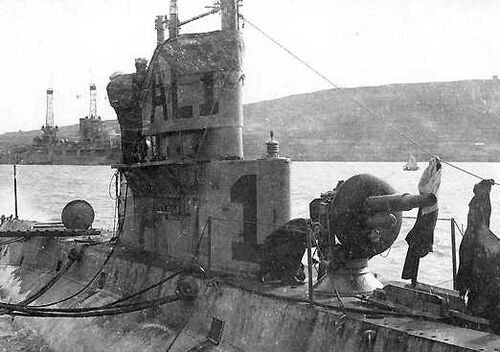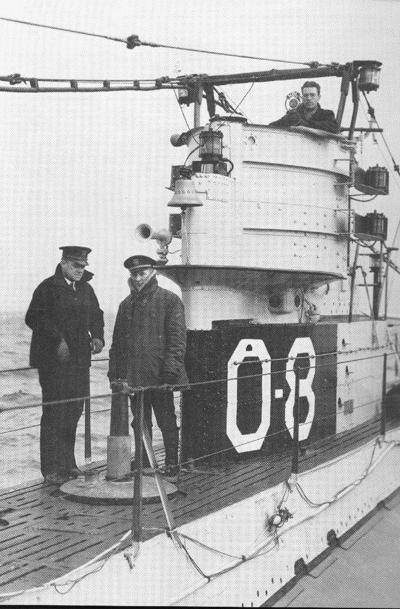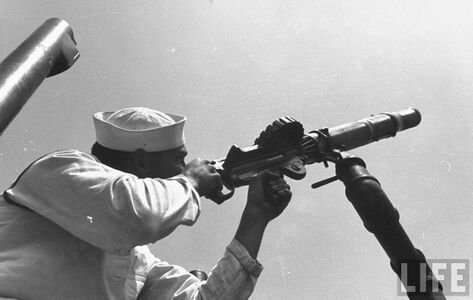Gun photos & information
Machine Guns
M1917 Lewis Machine Gun
-
Photo courtesy of the Life Magazine archives, a copy in the private collection of Ric Hedman.
-
Photo courtesy of the Australian War Memorial.
The M1917 Lewis light machine gun rose to prominence during WWI. It was a popular infantry weapon on the front in Europe and it also saw extensive use on aircraft. Despite being only .30-06 caliber, it had an imposing look due to the large heat-sink cooling tube that surround the main barrel. This tube had fins on the inside that helped to disperse heat while firing. The 47 round pan magazine sat atop the weapon and could be quickly changed. The Navy adopted the weapon during the war and it became the first machine gun to equip U.S. submarines. It was used as a self-defense weapon and in an anti-aircraft mode. It could be fired from the shoulder using the standard stock and bipod mount, or attached to a pintle mount topside (usually on the bridge). This photo shows the weapon being aimed from the bridge, using an optional vertical handle in place of the stock.
Although these guns were undoubtedly still in use through WWII (likely on the O & R-class training boats), they had been largely supplanted by the M1918 Browning Automatic Rifle and the M2 .50 caliber machine guns.

A color photo of the Lewis, with two open pan magazines on display. Although it was a little tedious to load the magazines with rounds, once loaded several magazines could be brought topside and quickly changed out by the gunner.
Some of the heat-sink fins can be seen just at the end of the large cooling tube, near the receiver.
Photo courtesy of Sturmgeweher.com.

A M1917 Lewis gun seen mounted above the trim manifold on the R-16 (SS-93) in 1923. This version has the standard stock installed.
Photo in the collection of the Vallejo Naval & Historical Museum. Contributed by Darryl Baker.
M1918 Browning Automatic Rifle

Use of this weapon onboard U.S. submarines continued in limited numbers into the 1960s, and the BAR saw service with the Army and Marine Corps well into the Vietnam war.
Photo courtesy of Historicalfirearms.com.
Deck Guns
3"/23 caliber Mk 9
The gun proved to be less than thrilling in its performance. It fired a small (13 lb.) shell that had only a .28 lb bursting charge. With the short 69 inch barrel the muzzle velocity was low. Combining these two factors resulted in a gun that lacked the hitting power to finish off even small targets quickly. It did not have any sort of central fire control and was used in line-of-sight mode only, thus limiting its accuracy from the pitching and rolling deck of a small submarine.
Reports were also received that the gun had the unnerving tendency to spontaneously retract into its tub without warning, especially with the recoil of firing. This obviously presented a dangerous safety hazard to the gun crew.
The gun was installed on most of the L-class boats, the M-1, the O-class, the San Francisco built units of the R-class (soon replaced with a 3"/50), and on the S-1. Its shortcomings had it removed from the L and O-classes after the end of WWI, and the installations on the R-boats and S-1 was short lived. By the late 1930s it was gone altogether.

This photo shows the gun raised and trained to starboard on the M-1. Note the very small amount of deck space to work the gun.
Photo in the private collection of Ric Hedman.

A view of the raised gun on L-1 from forward. The circular shield is clearly seen, with the recoil cylinder protruding below the barrel. This was the original version of the mount, with the cone shaped base. It was used on the L-class and the M-1.
Photo via Navsource.org.

The gun shown retracted on the O-8, just in front of the two officers, early 1920s. In this mode the gun looked like a thick stanchion post. The gun tub penetrated the pressure hull in the forward battery compartment and used up a lot of space. This was another reason that the gun was disliked by the crews.
Photo in the private collection of Ric Hedman.

This photo shows the raised mount on the R-20, 1919. This is the revised mount that was used on the O and R-class submarines. It had clips on the side between the base and the gun that held ready service ammo, used until more rounds could be handed up from below.
Photo courtesy of the Vallejo Naval & Historical Museum in Vallejo, California via Darryl Baker.
3"/50 Mark 7 Mod 19
Page created by:
Ric Hedman & David Johnston
1999 - 2023 - PigBoats.COM©
Mountlake Terrace, WA, Norfolk, VA
webmaster@pigboats.com


